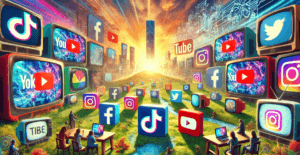Social Media Is Taking Over Entertainment—Can Streaming Services Keep Up?
Hollywood studios and streaming services face growing competition from social media platforms, which offer free, personalized videos and advanced advertising. As people’s entertainment habits shift, especially among younger generations, they spend more time on social media, gaming, and streaming, moving away from traditional TV. Cable TV is losing subscribers, especially with younger viewers opting for cheaper, digital alternatives. Streaming services are also becoming more expensive, with subscription costs rising and causing high churn rates.
To combat this, some platforms are introducing ad-supported plans. However, social media’s superior ad targeting and influencer-driven content give it a significant edge. Studios and streaming services must adapt to survive in this changing landscape.

Social Media Is Taking Over Entertainment—Can Streaming Services Keep Up?
Big Hollywood studios and streaming platforms like Netflix are no longer just competing with each other—they’re now up against social media giants like TikTok, YouTube, and Instagram. These platforms offer endless free videos, personalized recommendations, and smarter ads, making them a top choice for younger audiences. As more people spend hours scrolling through short videos instead of watching traditional TV or movies, the old-school entertainment industry is scrambling to keep up.
Shifting Entertainment Preferences
A recent study by Deloitte shows that the average American spends about six hours daily on entertainment, but this time is split across streaming, social media, gaming, music, and podcasts. Since total entertainment hours aren’t increasing, every platform is fighting for a slice of the same attention pie. Younger generations, especially Gen Z and Millennials, are ditching cable TV for digital options. Instead of sitting through scheduled TV shows, they bounce between streaming services, social media clips, and video games, often using multiple devices at once.
Cable TV’s Decline
Cable and satellite TV are still profitable but losing subscribers. Three years ago, 63% of households had cable—now it’s down to 49%. Younger viewers are cutting the cord fastest, with many planning to cancel soon. The main reasons people keep cable are live sports and news, but even that’s fading as streaming platforms acquire sports rights and social media floods feeds with free game highlights. Cost is another issue: the average cable bill is $125/month, while bundling four streaming services costs roughly $69. Even live TV streaming options like YouTube TV (priced higher than regular streaming) are losing appeal as younger audiences opt for cheaper—or free—social media content.
Streaming’s Price Problem
Streaming was supposed to be the affordable alternative, but prices are rising. Over half of Americans rely on streaming for paid entertainment, but many complain about costs. Subscription fees jumped 13% last year, with the average home paying $69/month for four services. Younger users often subscribe to five services but face 20% higher costs than older generations. Consumers say the “fair price” for an ad-free streaming plan is $14/month, yet most services charge more. A $5 price hike could push 60% of users to cancel. This has led to “subscription hopping”—39% of users canceled a service in six months, and over half of Gen Z and Millennials switch plans based on what’s trending or affordable.
The Ad War: Streaming vs. Social Media
To keep subscribers, streaming platforms now offer cheaper, ad-supported tiers. Over half of users opt for these plans, which average $9/month—close to what viewers say they’re willing to pay for a few ads per hour. But social media has a huge edge here. Platforms like Instagram and TikTok use advanced AI to target ads with pinpoint accuracy, making their ads feel more relevant to younger audiences. Gen Z and Millennials say social media ads align better with their interests than those on TV or streaming. Since social media already dominates digital ad revenue, Hollywood studios face an uphill battle to attract advertisers.
Why Social Media Feels Like “New TV”
For many, especially Gen Z, social media isn’t just for memes—it’s replacing traditional TV. Over half say social content feels more relatable than Hollywood productions. They spend far more time watching influencers’ videos than movies or shows. Creators on platforms like YouTube build loyal fanbases with free, easily accessible content. Social media companies are even using AI tools to help creators grow and monetize their channels, blurring the line between amateur and professional content. Some influencers have crossed over to TV or streaming, but fans are split—while some love seeing creators on bigger screens, others feel they lose their authenticity.
What’s Next?
To survive, studios and streamers are testing new strategies: bundling services (like Disney+ with Hulu) and pushing ad-supported plans. But competing with social media’s free, endless content and influencer-driven communities won’t be easy. The entertainment industry is at a crossroads. The winners will be those who balance affordability, smart advertising, and genuine audience connection—whether through hit shows, viral social campaigns, or partnering with creators. One thing’s clear: the era of flipping through cable channels or binge-watching a single streaming service is fading. The future is fragmented, personalized, and shaped by scrolls, swipes, and algorithms.
You must be logged in to post a comment.